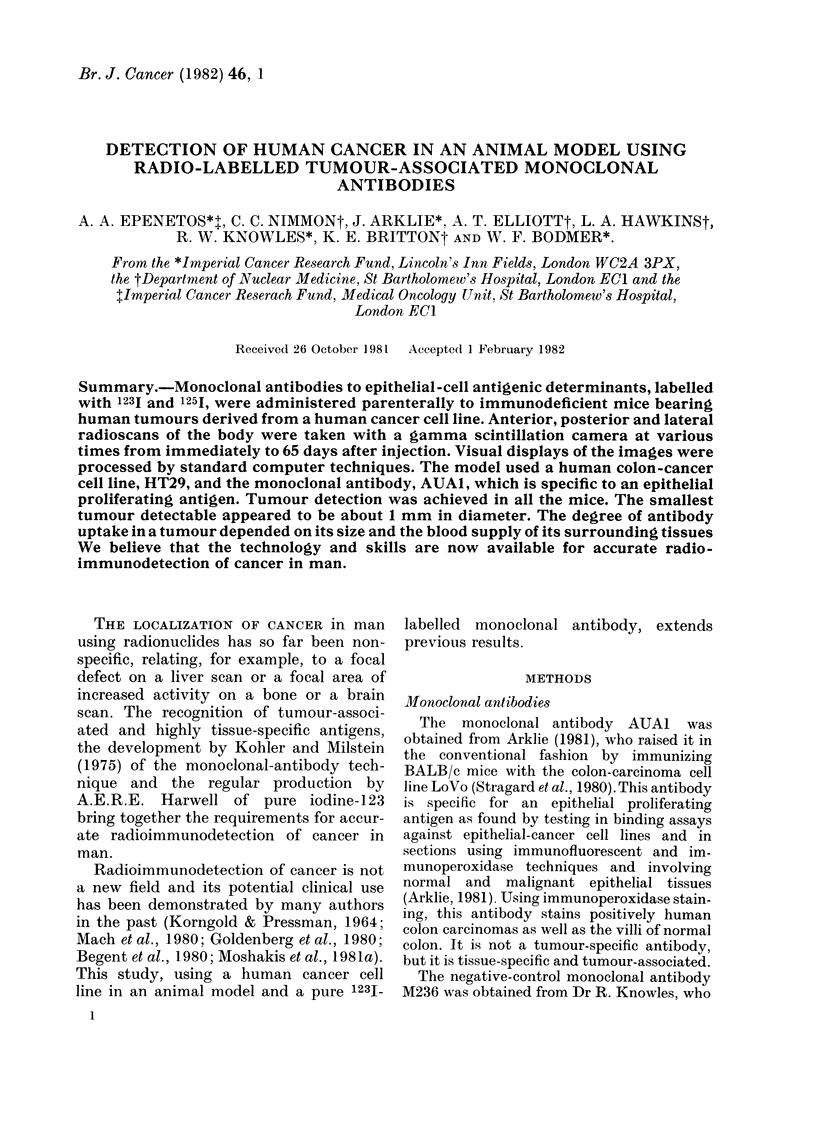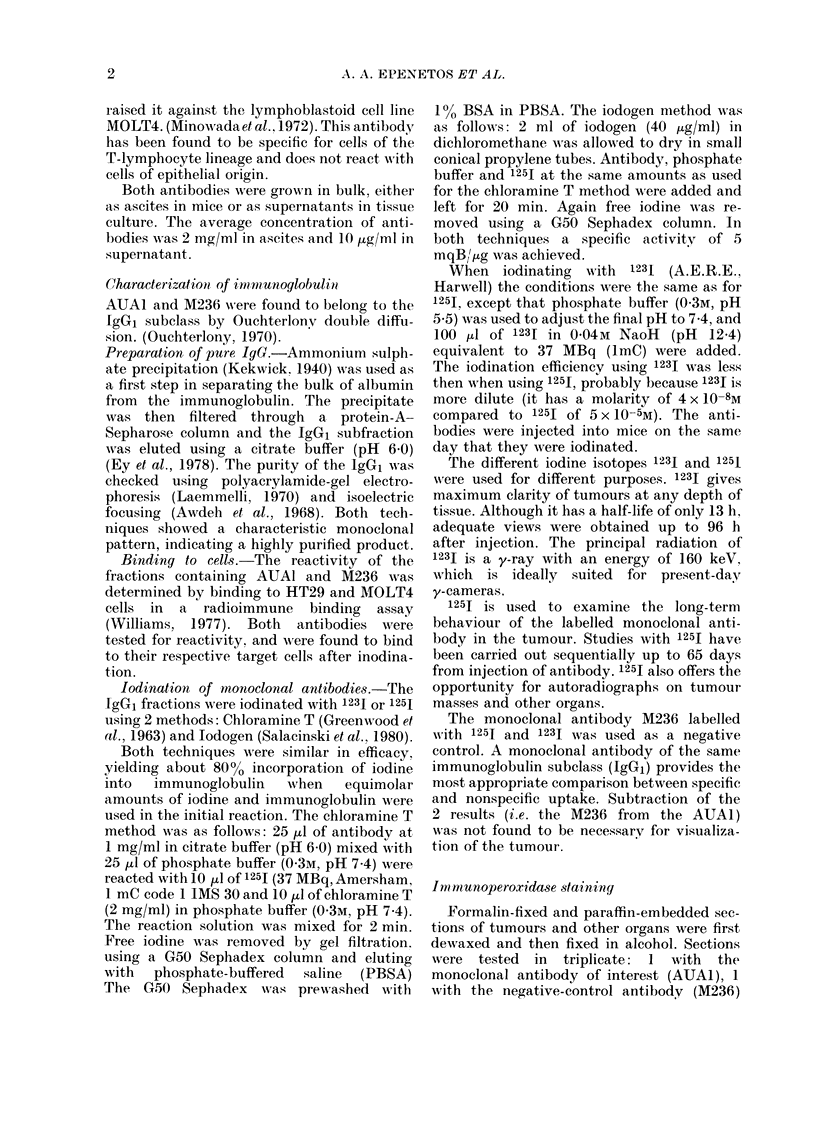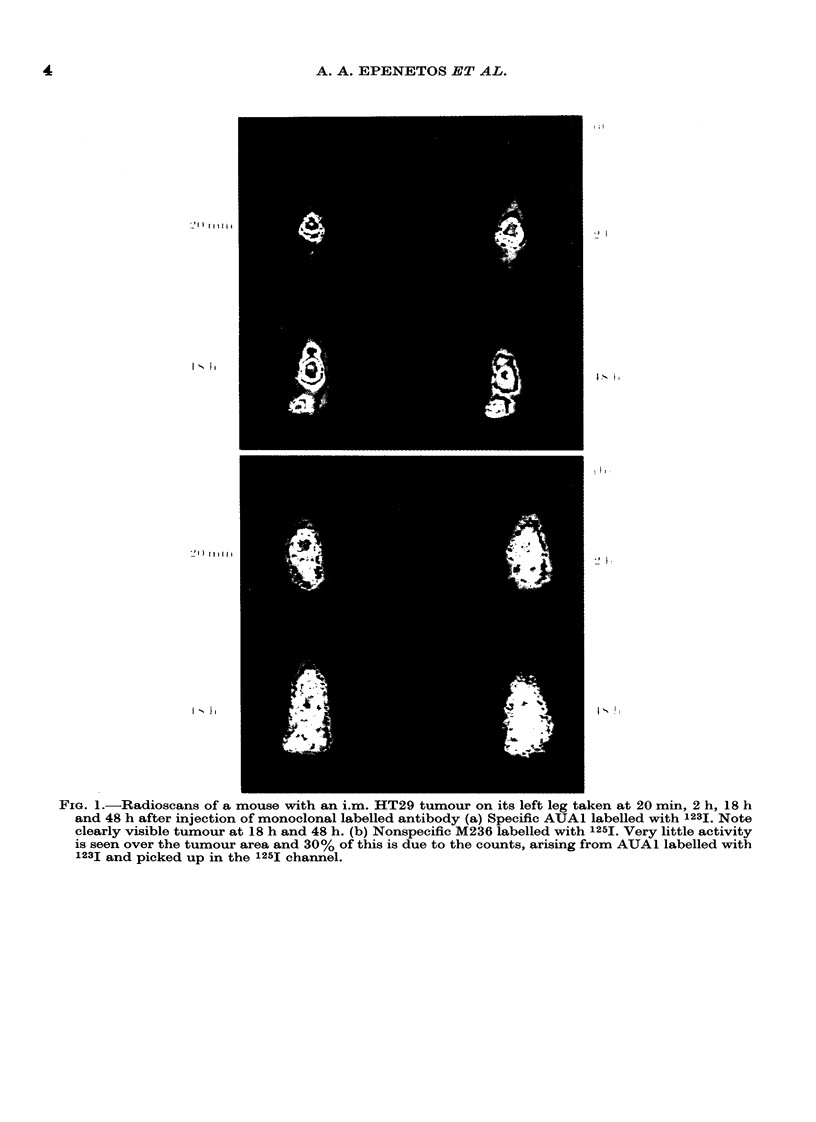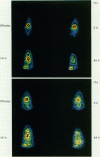Abstract
Monoclonal antibodies to epithelial-cell antigenic determinants, labelled with 123I and 125I, were administered parenterally to immunodeficient mice bearing human tumours derived from a human cancer cell line. Anterior, posterior and lateral radioscans of the body were taken with a gamma scintillation camera at various times from immediately to 65 days after injection. Visual displays of the images were processed by standard computer techniques. The model used a human colon-cancer cell line, HT29, and the monoclonal antibody, AUA1, which is specific to an epithelial proliferating antigen. Tumour detection was achieved in all the mice. The smallest tumour detectable appeared to be about 1 mm in diameter. The degree of antibody uptake in a tumour depended on its size and the blood supply of its surrounding tissues We believe that the technology and skills are now available for accurate radioimmunodetection of cancer in man.
Full text
PDF







Images in this article
Selected References
These references are in PubMed. This may not be the complete list of references from this article.
- Arklie J., Taylor-Papadimitrious J., Bodmer W., Egan M., Millis R. Differentiation antigens expressed by epithelial cells in the lactating breast are also detectable in breast cancers. Int J Cancer. 1981 Jul 15;28(1):23–29. doi: 10.1002/ijc.2910280105. [DOI] [PubMed] [Google Scholar]
- DeLand F. H., Kim E. E., Simmons G., Goldenberg D. M. Imaging approach in radioimmunodetection. Cancer Res. 1980 Aug;40(8 Pt 2):3046–3049. [PubMed] [Google Scholar]
- Ey P. L., Prowse S. J., Jenkin C. R. Isolation of pure IgG1, IgG2a and IgG2b immunoglobulins from mouse serum using protein A-sepharose. Immunochemistry. 1978 Jul;15(7):429–436. doi: 10.1016/0161-5890(78)90070-6. [DOI] [PubMed] [Google Scholar]
- Fogh J., Fogh J. M., Orfeo T. One hundred and twenty-seven cultured human tumor cell lines producing tumors in nude mice. J Natl Cancer Inst. 1977 Jul;59(1):221–226. doi: 10.1093/jnci/59.1.221. [DOI] [PubMed] [Google Scholar]
- GREENWOOD F. C., HUNTER W. M., GLOVER J. S. THE PREPARATION OF I-131-LABELLED HUMAN GROWTH HORMONE OF HIGH SPECIFIC RADIOACTIVITY. Biochem J. 1963 Oct;89:114–123. doi: 10.1042/bj0890114. [DOI] [PMC free article] [PubMed] [Google Scholar]
- Goldenberg D. M., Kim E. E., DeLand F. H., Bennett S., Primus F. J. Radioimmunodetection of cancer with radioactive antibodies to carcinoembryonic antigen. Cancer Res. 1980 Aug;40(8 Pt 2):2984–2992. [PubMed] [Google Scholar]
- KORNGOLD L., PRESSMAN D. The localization of antilymphosarcoma antibodies in the Murphy lymphosarcoma of the rat. Cancer Res. 1954 Feb;14(2):96–99. [PubMed] [Google Scholar]
- Köhler G., Milstein C. Continuous cultures of fused cells secreting antibody of predefined specificity. Nature. 1975 Aug 7;256(5517):495–497. doi: 10.1038/256495a0. [DOI] [PubMed] [Google Scholar]
- Laemmli U. K. Cleavage of structural proteins during the assembly of the head of bacteriophage T4. Nature. 1970 Aug 15;227(5259):680–685. doi: 10.1038/227680a0. [DOI] [PubMed] [Google Scholar]
- Mach J. P., Carrel S., Forni M., Ritschard J., Donath A., Alberto P. Tumor localization of radiolabeled antibodies against carcinoembryonic antigen in patients with carcinoma: a critical evaluation. N Engl J Med. 1980 Jul 3;303(1):5–10. doi: 10.1056/NEJM198007033030102. [DOI] [PubMed] [Google Scholar]
- McNabb T., Koh T. Y., Dorrington K. J., Painter R. H. Structure and function of immunoglobulin domains. V. Binding, University of immunoglobulin G and fragments to placental membrane preparations. J Immunol. 1976 Sep;117(3):882–888. [PubMed] [Google Scholar]
- Minowada J., Onuma T., Moore G. E. Rosette-forming human lymphoid cell lines. I. Establishment and evidence for origin of thymus-derived lymphocytes. J Natl Cancer Inst. 1972 Sep;49(3):891–895. [PubMed] [Google Scholar]
- Moshakis V., McIlhinney R. A., Raghavan D., Neville A. M. Localization of human tumour xenografts after i.v. administration of radiolabeled monoclonal antibodies. Br J Cancer. 1981 Jul;44(1):91–99. doi: 10.1038/bjc.1981.153. [DOI] [PMC free article] [PubMed] [Google Scholar]
- Moshakis V., McIlhinney R., Raghavan D., Neville A. M. Monoclonal antibodies to detect human tumours: an experimental approach. J Clin Pathol. 1981 Mar;34(3):314–319. doi: 10.1136/jcp.34.3.314. [DOI] [PMC free article] [PubMed] [Google Scholar]
- Stragand J. J., Bergerat J. P., White R. A., Hokanson J., Drewinko B. Biological and cell kinetic properties of a human colonic adenocarcinoma (LoVo) grown in athymic mice. Cancer Res. 1980 Aug;40(8 Pt 1):2846–2852. [PubMed] [Google Scholar]
- Taylor-Papadimitriou J., Peterson J. A., Arklie J., Burchell J., Ceriani R. L., Bodmer W. F. Monoclonal antibodies to epithelium-specific components of the human milk fat globule membrane: production and reaction with cells in culture. Int J Cancer. 1981 Jul 15;28(1):17–21. doi: 10.1002/ijc.2910280104. [DOI] [PubMed] [Google Scholar]





